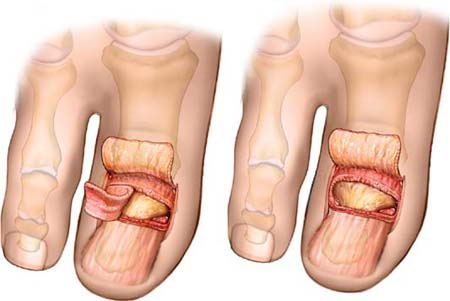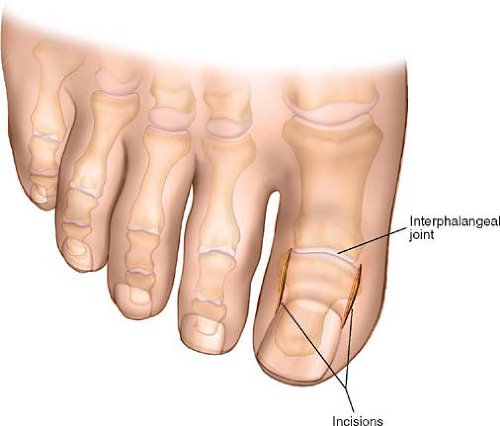 Approach for Nail Bed Ablation
Approach for Nail Bed AblationNail bed ablation is commonly performed for ingrown toenails as well as for onychogryphosis. Nearly all of these surgeries are carried out on the hallux.
Nail bed ablation involves excision of the entire nail bed and should result in complete removal of the nail without any recurrence. All surgical procedures, however, carry a significant risk of leaving a small part of the germinal matrix of the nail bed behind, thus recurrence rates in most series are approximately 25% to 30%.
Nail bed ablation has decreased in popularity in recent years with the increased use of chemical treatment of the nail bed.
The presence of acute infection is a contraindication to nail bed ablation. In such cases, lesser surgical procedures—such as partial wedge resection and local treatment—are indicated. Once the infection dissipates, a nail bed ablation can be carried out.
Position of the Patient
Place the patient supine on the operating table. After exsanguination, place a tourniquet on the middle of the thigh. Alternatively, use a soft rubber bandage to exsanguinate the foot, then wrap the leg tightly just above the ankle (see Fig 1-1). The use of a rubber tourniquet around the base of the toe is indicated when a digital ring block is used for anesthesia.
Landmarks and Incisions
Palpate the interphalangeal joint of the hallux, flexing and extending the joint to confirm its position. Observe the lunula of the nail. This marks the distal extension of the nail bed.
Make two oblique incisions. Begin at the base of the nail on either the medial or lateral edge and extend the skin incision across the dorsal aspect of the distal phalanx, ending them at the level of the interphalangeal joint of the hallux (Fig. 51-1).
Stay updated, free articles. Join our Telegram channel

Full access? Get Clinical Tree



